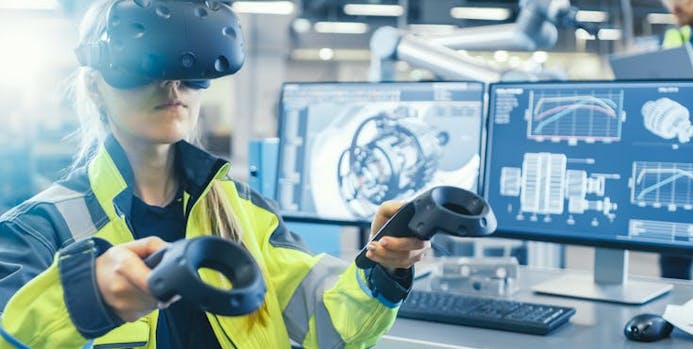Virtual and augmented reality in manufacturing
2019-12-05
3 min read
The concept of virtual reality (VR) and augmented reality (AR) were originally designed for gaming. However, they are quickly gaining popularity in the industrial sector.
This post comes to us courtesy of Jonathan Wilkins, the marketing director at EU Automation, a provider of automation parts. He discusses how VR and AR can enhance safety and boost productivity in the factory.
Immanuel Kant coined the term "virtual reality" more than 200 years ago. Describing VR as a reality that exists in our minds and is distinct from the external physical world.
We use the word "virtual reality" in a different way today. However, the concept of VR still retains Kant’s idea. A world that is not physically there but that our minds can clearly perceive.
There are different ways of digitally controlling someone’s perception of reality. The easiest way is to enhance the user’s perception of the external world by adding digital elements to it. A technique called augmented reality (AR).
For example, a tourist can see information about historical buildings projected directly onto the buildings’ facades, with AR glasses. Casa Battló in Barcelona is a place where such things occur. VR takes this one step further by completely replacing the user’s reality with a digitally generated one.
Recently, the manufacturing sector has discovered the benefits of AR and VR. Cutting costs and increasing safety and productivity. But what exactly are the applications of augmented reality in factories?

1. How VR can speed up production:
Forward thinking corporations use VR to improve their approach to predictive analytics in manufacturing. Digitally interacting with a product allows you to discover a design issue in only a few minutes. Whereas, it could take weeks of data analysis to find the same flaw.
Manufacturers can apply the same process to the whole production line. By studying the production process in a virtual environment, producers can find bottlenecks and areas that need improvement. VR also eliminates the need to build actual, full-scale models.
This can be very convenient in sectors such as aerospace manufacturing. The reason for this is that prototyping can be very costly.
2. How can we improve safety in manufacturing with VR?
VR is also very effective in another area, which is safety. By digitally simulating the production processes, it’s possible to identify dangerous movements in advance. Automotive giant Ford, for example, has already reduced employees’ injuries by 70 per cent thanks to virtual reality in manufacturing.
Businesses can use the same method to increase product safety for buyers. By recreating realistic conditions under which consumers will use the product. For example, automotive manufacturers can reproduce various weather and traffic conditions to optimise the safety features of their vehicles.
3. AR for Maintenance and repair:
AR can facilitate maintenance. Technicians can, for instance, have data relevant to their work displayed on the machine part they're inspecting or fixing. This removes the need to consult charts and instruction manuals. Thus, speeding up the repair process.
Moreover, the information projected, guides the operator. So, even an inexpert worker can perform the right repairs.
In a similar way, specialists can use AR to deliver support without flying over the globe. An expert can remotely guide any employee equipped with AR glasses. These experts provide support by simply simulating the actions that the employee should perform. You can also use this technique to train new employees.
Moreover, both AR and VR can give great support in preparing staff for emergency procedures.
For Kant, VR was something that only existed in our minds. Nowadays, AR and VR have practical applications that forward thinking automative parts manufacturers are already taking advantage of.



